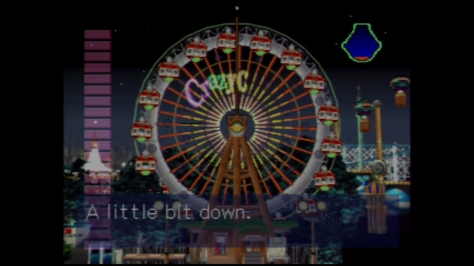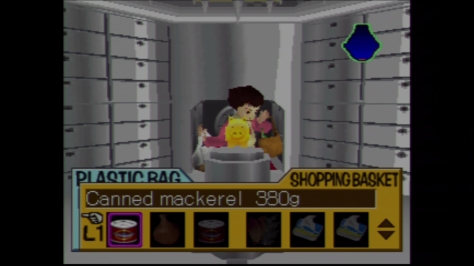
I had a pretty memorable Independence Day this year. Among other reasons, I finally sat down and played through Incredible Crisis. It’s a quirky game that has been on my backlog for a while now, and on my radar for even longer; I probably first learned of it surfing the net in the mid 2000s. For me, it’s remained a stalwart example of the scores of zany Japanese games that somehow saw release in the west during the late 1990s and the mid 2000s. Maybe off-the-wall games like it had been, and perhaps remain, prevalent in Japan, but at least in the west, it seemed like they came and went during these years.
A continually rising appetite for video games around the world, specifically surrounding the popularity of the PlayStation, and familiarity with development tools unquestionably allowed smaller and medium-sized companies to take creative gambles, causing weird games like this to flourish in that era. But, after enough commercial flops and ever-increasing development costs, studios shuddered, were absorbed, or transitioned into mobile development. Although this last reality is grouped with unfortunate outcomes, it’s not meant as a negative; it’s just, after years of seeing such creative output on home consoles (the big leagues, as it were), it was disappointing to see so many folks seemingly relegated to that, admittedly bountiful, but fleeting space.

Kenichi Nishi is a great example. He got his start as a designer on various RPGs and action games at Telenet Japan, specifically their Renovation Game and then Riot internal development studios. Of note, Telenet Japan is perhaps best known for their Wolf Team development house, which developed the first Tales of game, and whose staff eventually served as the foundations of both tri-Ace and Namco Tales Studio. It seems Kenichi Nishi left Telenet around the time of company restructuring in 1993; he wound up as a field designer at Square, working on Chrono Trigger and Super Mario RPG: Legend of the Seven Stars; maybe you’ve heard of them?
Following this brief stint, he founded Love-de-Lic with fellow Square staff. They only developed three games, and none saw release outside their native Japan, but they remain highly desirable imports. Among them, Moon: Remix RPG Adventure, designed by Kenichi Nishi himself, was the most revolutionary. It revolves around a young boy sucked into his RPG game, only to find out that the protagonist is poorly regarded; after all, the hero is wandering into people’s homes and killing wildlife with reckless abandon. To remedy this, the boy learns to gain love, not levels. It was maybe the first game designed around a meta-commentary on the RPG genre, and somewhat miraculously, it’s getting localized for western audiences after 27 years.

With the release of L.O.L.: Lack of Love on the Dreamcast in 2000, which featured a score by Ryuichi Sakamoto of Yellow Magic Orchestra fame, whose Technodelic album served as inspiration for their studio name, Love-de-Lic was finished. That same year, Kenichi Nishi founded Skip, Ltd. Working in concert with Nintendo, Skip is responsible for the Chibi-Robo! series, and the Japan-only bit Generations games for the Game Boy Advance. The studio operates to this day, but following scenario work on Captain Rainbow and contract work on Wacky World of Sports, it appears Kenichi Nishi has focused on mobile app development. The most notable output of this latter period are the newtonica games, which were a collaboration with the late Kenji Eno, whose game D I played just a few months ago.
Like Skip, Ltd., Polygon Magic is a Japanese game development studio still kicking after two decades. Founded in Tokyo, in 1996, Polygon Magic has developed quite the variety of games through the years, from arcade fighters and survival horror games, to their bread and butter today: mobile games. But, back in the late 1990s, they developed Incredible Crisis. Produced primarily by Tokuma Shoten, a Japanese magazine publisher who also released the game in Japan (their last, after fifteen years), and in conjunction with Hakuhodo and Toppan, advertising and printing companies, respectively, Kenichi Nishi served as the lead designer and writer. It launched in Japan June 24, 1999, and released in the United States November 6, 2000, a mere two weeks after the launch of the PlayStation 2. Titus Software handled publishing duties in the west.

Incredible Crisis follows a day in the life of the Tanamatsuri family, and it’s a special one: it’s grandma’s 80th birthday! She doesn’t ask for much when they’re sitting around the table eating breakfast, only for them to arrive home early to celebrate. It’s a simple enough request, but each family member’s day escalates so absurdly, just surviving is tough enough. Divided into four distinct sections, each highlighting a different family member, the game boiled down to a story-driven minigame collection. Sadly, despite wacky scenarios, the minigames themselves weren’t especially enjoyable. They were simplistic affairs, and too often, implemented similar gameplay. Playing the game grew tedious quickly, but I still found it worthwhile to see what crazy event would happen next.
Taneo, the patriarch of the family, was the first to have his day showcased. He worked as a salaryman and his job offered midday dance routines as exercise. A brief rhythm minigame ensued. It took a few missed button prompts to “get” the timing, but it was easy enough to catch on before failing outright. As the first minigame, and a music-orientated one at that, it was a prime showcase for the game’s unique soundtrack. Scored entirely by the Tokyo Ska Paradise Orchestra, the group’s songs were often energetic, with a commanding rhythm section and prominent horns. Their instrumental ska music amplified the intensity of stressful situations, while keeping things light-hearted.

When the installation of a nearby statue’s globe went awry, his dance session, and the rest of his workday was cut short. Getting home was a hassle, with many detours, such as a sensual ride on a Ferris wheel. Accepting the invitation of an attractive woman, who was a prominent character in everyone’s adventures, Taneo gave her a suggestive back massage in their private passenger car. Presented with a static exterior shot of the Ferris wheel, I moved his hands up, down, left, and right based on her sultry directions. When I finally located the magic spot, I mashed X, triggering a euphoric reaction from the beautiful stranger; it was like a sexy game of Battleship.
I’m sure Etsuko, his wife, wouldn’t approve of this encounter, but she had her hands full elsewhere. Having promised to make her mother-in-law’s favorite meal, she had ventured into town to acquire ingredients. Finding herself in the wrong place at the wrong time, she wound up as a forced accomplice to a bank robbery, and being given orders by the same woman who had tantalized Taneo. She was mixed up with them for a few minigames, first trying to stealthily avoid them in a bank, then helping them steal a piggy bank, and eventually making a break for it on a snowboard. The piggy bank minigame was particularly novel, as I had to cherry pick her groceries and place into a separate bag that matched its weight, à la the boulder scene from Raiders of the Lost Ark. This was far from the only scene that parodied popular films, and the works of Steven Spielberg frequently served as inspiration.

Her story came to close with what were probably my two favorite minigames. After escaping the bank robbers via snowboard, she found herself in the presence of military jet fighters. Deciding there was no better way to get home quickly, she hopped in one! Tasked with flying the jet out of the tunnel-like hangar, I played a fast-paced minigame that could’ve passed as a pared down Zaxxon sequel. From an off-center behind-the-back perspective, I dodged opening and closing hangar doors and myriad jets flying at Etsuko. Upon exiting the extremely long tunnel, she had a showdown against a massive teddy bear. She flew around her nemesis as though it was an All-Range stage from Star Fox 64. Sadly, the only responsibility I was given was firing missiles when she locked onto the target.
As the action transitioned to the kids, a real bummer of a minigame kicked things off. Through happenstance Tsuyoshi, the 9-year old son, had been shrunk down to the size of an insect, and he needed to escape one immediately! Inside the pit of an antlion, I pressed the X button in time with a meter to have the young boy climb out. But, mudslides occasionally occurred and needed to be dodged by rolling left or right. These set Tsuyoshi back a good ways if he was ensnared, and I had a rough time avoiding them! Since I kept making progress with the meter climbing section, I never actually reached a fail-state; it just took me longer than it should’ve to complete.

A stress meter was present in all minigames and fluctuated based on my performance. If I performed poorly, it filled up until the guy depicted blew his top, and I lost a life. These could be obtained by performing exceptionally well, but in my playthrough, were never an issue. Completing sections of the story mode unlocked minigames for individual play from the main menu. Honestly though, I didn’t find many of them enjoyable enough to want to experience again, other than to subject friends and family to the madness of Incredible Crisis. I can think of two minigames off the top of my head that offered some variation, but replaying most wouldn’t offer anything new. Unlike entries in the WarioWare series, these minigames weren’t rearranged with extended versions, high scores, or unlockables.
Although both kids had their own distinct sections, their time in the limelight was comparatively brief. For Ririka, the 17-year old daughter, that can be partially explained by a minigame cut from the western release. A fairly lengthy karaoke minigame starring Ririka and her friends was cut ahead of release, due localization difficulties; another featuring Taneo was also axed. Interestingly, this latter one was apparently good enough to be selected for the arcade version of Incredible Crisis, which Tecmo released in Japan. It featured a trimmed down selection of minigames, and none of the cutscenes. I don’t think we missed much in not receiving this version in the west, but I will say, after playing roughly half of the game with an arcade stick, it was a good fit; especially the turbo feature!

Before I had even finished Incredible Crisis, I was already thinking about how to structure a review. Most of that consideration went out the window when I began researching Kenichi Nishi, however. Having only dabbled with some of his other works, it’s hard to definitively say how much of his influence shines through in this game, but at least conceptually, it seems to fit his gameography well. Unfortunately, Incredible Crisis was more fun to watch than to play. The unpredictability and absurdity had me well enough engaged to see that the Tanamatsuri’s were able to celebrate grandma’s birthday, but the uninspired minigame design was disappointing; I could only mash X so many times before the novelty of what was taking place lost its appeal. Still, topping out with a two-hour runtime, it was the perfect length to cede the game’s faults and relish the good times.

One thought on “Incredible Crisis [PlayStation] – Review”